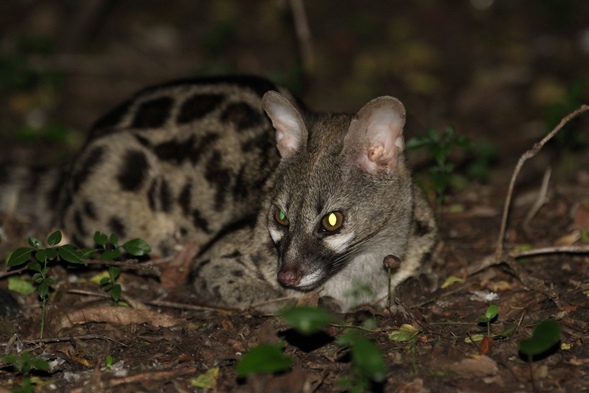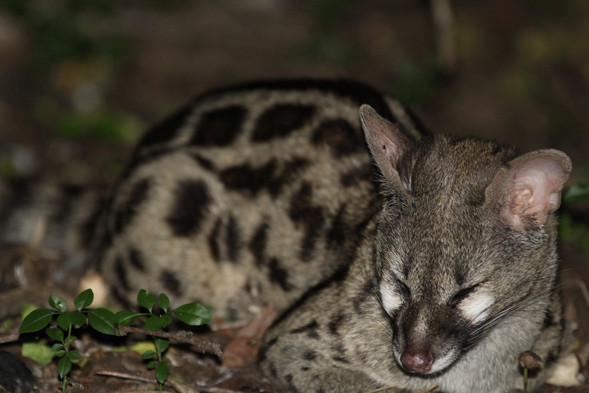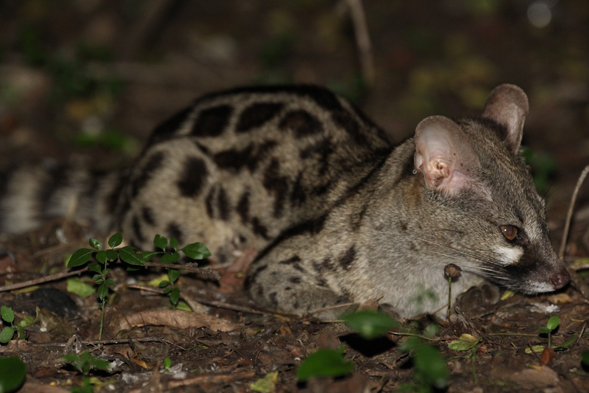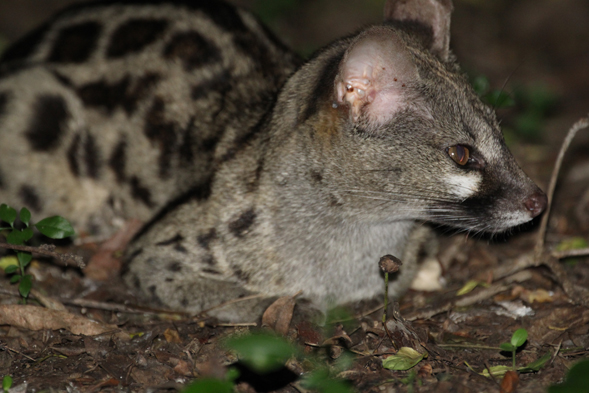It looks like you're using an Ad Blocker.
Please white-list or disable AboveTopSecret.com in your ad-blocking tool.
Thank you.
Some features of ATS will be disabled while you continue to use an ad-blocker.
12
share:
I decided to open a thread on this great animal, because it lives only in SA, and most South Africans has never seen one in their lives.
But elsewhere in the world they are kept as pets.
That is why I thought I would share the photos I took of one, and give some information about them.

This is the Cape Genet. I took these photos in the Kruger National Park one night when he came out to catch some moths and bugs that was attracted by our lights. He was amazingly quick, just waiting for the right moment to jump up into the air and catch whichever bug he though would make a nice snack.




Do any of you own one of these beautiful animals?
But elsewhere in the world they are kept as pets.
That is why I thought I would share the photos I took of one, and give some information about them.

This is the Cape Genet. I took these photos in the Kruger National Park one night when he came out to catch some moths and bugs that was attracted by our lights. He was amazingly quick, just waiting for the right moment to jump up into the air and catch whichever bug he though would make a nice snack.
The Cape genet (Genetta tigrina), also known as the blotched genet, large-spotted genet or muskeljaatkat in Afrikaans, is a carnivore mammal, related to the African linsang and to the civets. It lives only in South Africa. Like other genets, it is nocturnal and arboreal. They prefer to live in the riparian zones of forests, as long as they are not marshy areas. The maximum life span is 8 years and its conservation status is low risk

Similar in appearance to the common genet (G. genetta), the Cape genet has yellowish-grey fur with rust-colored and black rosettes, with a black and white tail. Individuals from drier areas of South Africa tend to have lighter colors and less stark patterns, while the opposite is the case in moister areas where they are found with darker and more striking patterns. The large spotted genet can be differentiated from other genets, especially the small spotted genet, by their very distinct large spots but also by their lack of long black crested hair along the spine.Melanistic individuals are known. The Cape genet has a long thin body and tail but has short legs. There is little difference in body type between the sexes. The skull and dentition of the Cape genet are much less specialized then those of Felidae. Cape genets have a longer jaw and more morals then the norm of Felidae. The dental formula is arranged: 3/3/1/1/4/4/2//2.
Body length ranges from 49 cm to 60 cm and the tail from 42 cm to 54 cm. Average mass of an adult Cape genet: 1.82 kg. Average basal metabolic rate: 4.189W.

Its diet is varied, and scientists consider it to be an opportunistic omnivore. Their diet consists of animals such as: birds, spiders, scorpions, fish, and insects. Various Cape genet specimens have been found to have over half of the stomach filled with invertebrates, which were most commonly of the orders Coleoptera, Orthoptera, and Isoptera. They also eat grass, which can aid digestion, dislodge hair in the intestines, induce vomiting to get rid of ingested toxins, relieve throat inflammation and stomach irritation. Another study has found that most of the prey that they consume is found in low lying bushes and that it primarily eats small rodents, with the main staple food being Dendromus sp. Birds appear to not be prevalent the Cape genet diet, which seem rather underrepresented in a semi-arboreal carnivore.

Heavily adapted to arboreal living, the Cape genet often remains hidden during the day in a tree or takes strong cover on ground to avoid heat. At night the Cape genet becomes more active, using its strong eyesight and agile capabilities to be a highly effective predator. Combining speed and stealth, the Cape genet will dash in an elusive fashion, broken up by short pauses, until it reaches its prey. Being primarily nocturnal animals, they also have a heavily developed olfactory system which has been found to mark intraspecies behavioral senses allowing for more complex hunting strategies, social interactions, and mating organization.
The Cape genet primarily lives solitary but can occasionally be found in pairs. Often the Cape genet can be found hissing and yapping which is a common communication strategy utilized by the Cape genet in stressful situations. Olfactory communication is evident with the sebaceous anal glands that secrete a musky odor. Though the olfactory communication mechanism is poorly understood, it is thought to communicate territory boundaries in certain cases and physiological states in others. Being a solitary species, olfactory communication is most likely very important in the life of the Cape genet, its social environment and life cycle. When walking on branches, the Cape genet will stay low and laterally swing its legs out so that any misstep is easily correctable. The Cape genet is very agile and has even been observed swimming

The genet is known for the killing of poultry, a quality that makes farmers, in particular, very un-fond of the genet. With poultry being the primary protein source of many African villages, the genet causes problems for the locals who are most affected. On the more positive side the genet also preys on rodents, possibly offering a control mechanism for the rodent population. As small land rodents negatively influence the economy, this control serves of great importance to regulating primarily rodents from the family Muridae. In addition to rodent control, the genet serves as an insect control as well, ridding many of the harmful pests in the local area. As insects are the intermediate hosts of many diseases in south eastern Africa, the Cape genet again benefits humans with an indirect disease control
The Cape genet is one of the species of genet kept as an exotic pet, in the U.S.A. and elsewhere.
Do any of you own one of these beautiful animals?
Very lucky to see one in nature! And especially to get a few good pics.
What a beautiful creature. Thanks for sharing!
What a beautiful creature. Thanks for sharing!
edit on 22-2-2015 by CraftBuilder because: (no reason given)
It looks like a possum and a cat mated and had babies!!!
He's too cute for words. Thanks for sharing something about this animal that I had never heard of before now. I do not own one as my husband would likely go into anaphylactic shock if he got within 100 yards of this beautiful animal.... (Note to self... Might be a nice Christmas present (for both of us).... I'm kidding!!)
I would love to have many animals that exist in the wild but the thought of taking them out of their natural habitat for my own pleasure prevents me from even looking into it. I'm glad folks can save and rehabilitate some wild animals, but to just catch them and rob them of a normal life so you can enjoy "owning it" doesn't sit well with me.
I would love to have a slow loris, a kangaroo (of course), and a fennec fox but they are all just too beautiful for me to even contemplate removing them from their natural habitat.
This little guy here is neat though and I enjoyed learning about something new today.
He's too cute for words. Thanks for sharing something about this animal that I had never heard of before now. I do not own one as my husband would likely go into anaphylactic shock if he got within 100 yards of this beautiful animal.... (Note to self... Might be a nice Christmas present (for both of us).... I'm kidding!!)
I would love to have many animals that exist in the wild but the thought of taking them out of their natural habitat for my own pleasure prevents me from even looking into it. I'm glad folks can save and rehabilitate some wild animals, but to just catch them and rob them of a normal life so you can enjoy "owning it" doesn't sit well with me.
I would love to have a slow loris, a kangaroo (of course), and a fennec fox but they are all just too beautiful for me to even contemplate removing them from their natural habitat.
This little guy here is neat though and I enjoyed learning about something new today.
a reply to: IndependentOpinion
It's related to civets? Teach that thing to eat coffee beans, collect the poo beans, roast beans, and profit!
en.m.wikipedia.org...
Maybe glue some moth wings on the beans and use a flyfishing rig.
It's related to civets? Teach that thing to eat coffee beans, collect the poo beans, roast beans, and profit!
en.m.wikipedia.org...
Maybe glue some moth wings on the beans and use a flyfishing rig.
So gorgeous! I'm not a fan of people having exotic pets and I'm thrilled you got to see this critter.
Wow! I have never even heard of these beautiful animals! Gorgeous!!!!! Thank you so much for sharing these pics!!

a reply to: Night Star
A pleasure Night! Maybe I will do regular thread on the animals I have came across her in SA.
A pleasure Night! Maybe I will do regular thread on the animals I have came across her in SA.
new topics
-
God's Righteousness is Greater than Our Wrath
Religion, Faith, And Theology: 3 hours ago -
Electrical tricks for saving money
Education and Media: 6 hours ago -
VP's Secret Service agent brawls with other agents at Andrews
Mainstream News: 7 hours ago -
Sunak spinning the sickness figures
Other Current Events: 8 hours ago -
Nearly 70% Of Americans Want Talks To End War In Ukraine
Political Issues: 8 hours ago -
Late Night with the Devil - a really good unusual modern horror film.
Movies: 10 hours ago -
Cats Used as Live Bait to Train Ferocious Pitbulls in Illegal NYC Dogfighting
Social Issues and Civil Unrest: 11 hours ago
top topics
-
VP's Secret Service agent brawls with other agents at Andrews
Mainstream News: 7 hours ago, 9 flags -
Cats Used as Live Bait to Train Ferocious Pitbulls in Illegal NYC Dogfighting
Social Issues and Civil Unrest: 11 hours ago, 8 flags -
Electrical tricks for saving money
Education and Media: 6 hours ago, 4 flags -
HORRIBLE !! Russian Soldier Drinking Own Urine To Survive In Battle
World War Three: 15 hours ago, 3 flags -
Nearly 70% Of Americans Want Talks To End War In Ukraine
Political Issues: 8 hours ago, 3 flags -
Sunak spinning the sickness figures
Other Current Events: 8 hours ago, 3 flags -
Late Night with the Devil - a really good unusual modern horror film.
Movies: 10 hours ago, 2 flags -
The Good News According to Jesus - Episode 1
Religion, Faith, And Theology: 13 hours ago, 1 flags -
God's Righteousness is Greater than Our Wrath
Religion, Faith, And Theology: 3 hours ago, 0 flags
active topics
-
VP's Secret Service agent brawls with other agents at Andrews
Mainstream News • 41 • : ThatSmellsStrange -
HORRIBLE !! Russian Soldier Drinking Own Urine To Survive In Battle
World War Three • 32 • : DaRAGE -
New whistleblower Jason Sands speaks on Twitter Spaces last night.
Aliens and UFOs • 55 • : baablacksheep1 -
Cats Used as Live Bait to Train Ferocious Pitbulls in Illegal NYC Dogfighting
Social Issues and Civil Unrest • 20 • : Asher47 -
Nearly 70% Of Americans Want Talks To End War In Ukraine
Political Issues • 12 • : Asher47 -
Electrical tricks for saving money
Education and Media • 4 • : Lumenari -
DONALD J. TRUMP - 2024 Candidate for President - His Communications to Americans and the World.
2024 Elections • 514 • : WeMustCare -
The Acronym Game .. Pt.3
General Chit Chat • 7744 • : bally001 -
Truth Social goes public, be careful not to lose your money
Mainstream News • 128 • : Astyanax -
Sunak spinning the sickness figures
Other Current Events • 5 • : glen200376
12
